Indoor cycling used to have a fearsome reputation for being excruciatingly boring. The idea of spending time on a turbo trainer, self-flagellating to heavy music while you stared numbingly at a wall, all in pursuit of some intangible fitness gains, seemed like a kind of madness.
However, with the best smart trainers and third-party interactive apps, realising the benefits of indoor cycling has never been easier or more fun. Read our top 5 indoor training tips for more inspiration.
If you’re looking to invest in an indoor training setup, you're in the right place. We've put the latest smart trainers through their paces to find out what's really worth spending your money on.
For more information on how to choose the right indoor trainer for your needs, read our full buyer's guide at the end of the article.
Editor's note: this article was updated on 13 January 2025.
Best smart trainers in 2025
JetBlack Victory

- £399 / $399 / €449.95 as tested
- Pros: Great value; easy setup; quiet; accurate data; ride feel
- Cons: ERG mode power smoothing can’t be turned off
The JetBlack Victory outshines the competition and sets a new standard for mid-range smart trainers.
With a ride feel that’s very similar to the Zwift Hub, pedalling feels fluid and realistic, while the trainer responds to changes to in-app gradients quickly.
Our tester found the JetBlack Victory has excellent data accuracy, which exceeds the expectations of its £400 price tag.
Added to this, the Victory is easy to set up and comes with a Zwift Cog. It’s also relatively quiet at 65db and the noise levels hardly increase when you start sprinting.
One drawback is you can’t turn off power smoothing in ERG mode. This might not be a concern for you, but it’s frustrating if you want to analyse your raw power data.
- Read more: JetBlack Victory smart trainer review
Specs
Max power: 1,800 watts | Max simulated gradient: 16 per cent | Weight: 12.9kg | Flywheel weight: 4.7kg | Noise: 65dB | Cassette included: Zwift Cog
Elite Suito
SQUIRREL_TEXT_13178160
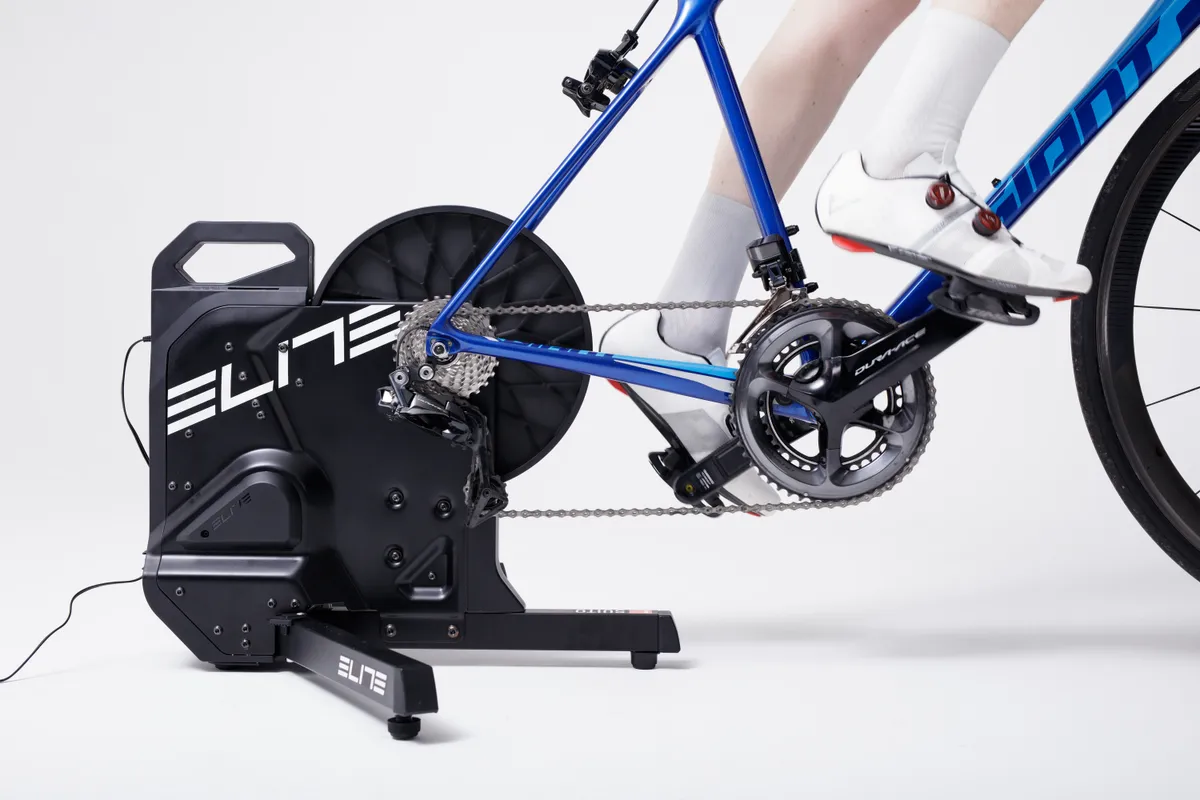
- £649.99 / $799 / €669 / AU$999 as tested
- Pros: Ease of use; price; stable
- Cons: Noisier than others
The Suito sits between the top-end Direto XR and budget Zumo in Elite's range of direct-drive smart trainers.
It comes ready to use straight out of the box, so there’s minimal fuss involved in setting it up and getting riding. It’s a great plug-and-play solution.
There's an 11-speed Shimano 105 cassette installed, and adaptors for 142mm thru-axles and a front-wheel riser block included in the box. This is all especially noteworthy at this price point.
Ride quality is very good, especially considering it doesn’t have the largest flywheel, and we were impressed by its stability when cranking things up.
It can simulate gradients of up to 15 per cent and has a maximum power of 1,900 watts, so the strongest riders might find this unit a little under-specced, but for most people, it will be more than they’ll ever need.
- Read more: Elite Suito review
Specs
Max power: 1,900 watts | Max simulated gradient: 15 per cent | Weight: 14.5kg | Flywheel weight: 3.5kg | Noise: 73dB | Cassette included: Yes
SQUIRREL_13178160
Wahoo Kickr Core Zwift One
SQUIRREL_TEXT_13079643

- £449.99 / $499.99 / €499.99 as tested
- Pros: Excellent ride feel; competitive spec; solid data accuracy
- Cons: No Race mode; not the quietest
The Wahoo Kickr Core was originally launched in 2018. But Wahoo relaunched the smart trainer in partnership with Zwift in 2024 and it still impresses.
The Kick Core is easy to set up and the Zwift Cog is a win for simplicity and compatibility. It has an excellent ride feel, thanks to its 5.4kg flywheel. Although its small profile might be misleading, it’s impressively stable when sprinting or climbing.
The trainer is missing a Race mode, which broadcasts your data at 10Hz for a more responsive experience in apps such as Zwift, but this won’t be a concern for everyone.
In terms of noise, the Kickr Core is louder than some competitors, but ‘quiet enough’ and our tester found it didn’t disturb others in his home.
The data and cadence accuracy are good for the trainer’s modest price.
- Read more: Wahoo Kickr Core Zwift One review
Specs
Max power: 1,800 watts | Max simulated gradient: 16 per cent | Weight: 18.79kg | Flywheel weight: 5.4kg | Noise: 65db | Cassette included: Zwift Cog included
SQUIRREL_13079643
Saris H3
SQUIRREL_TEXT_13089503
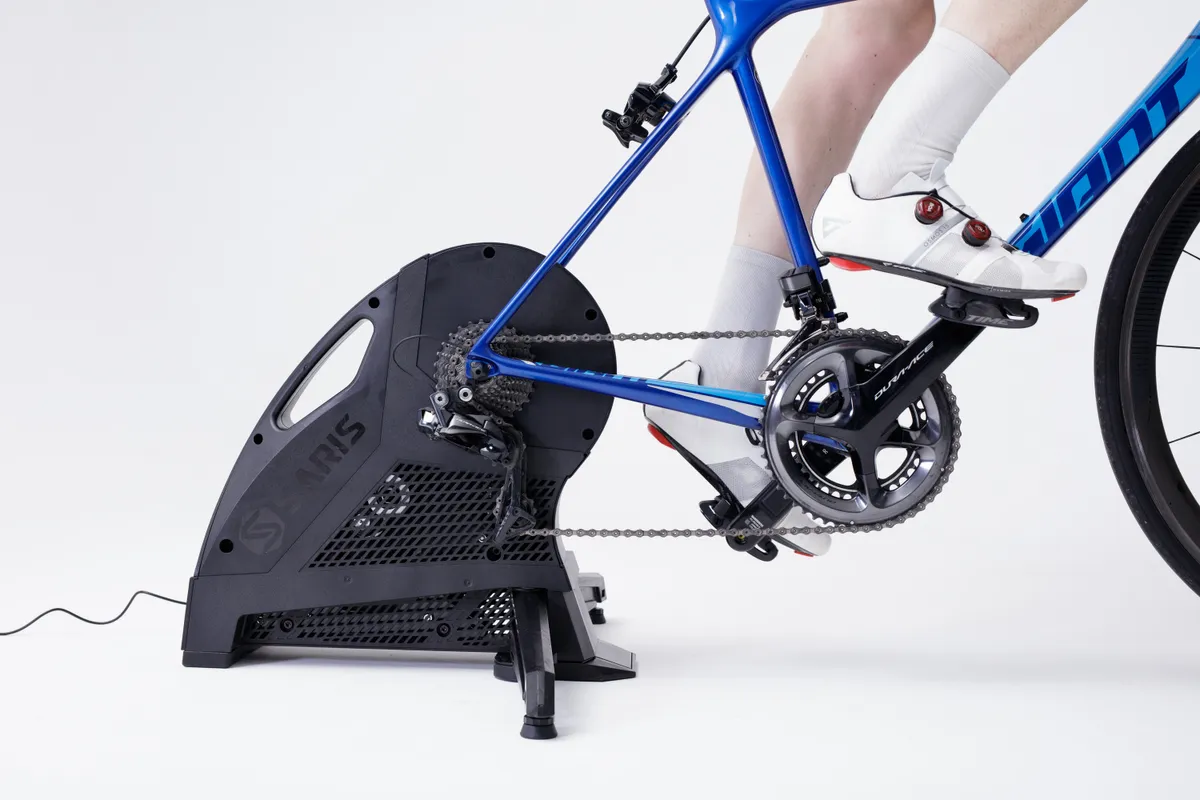
- £749.99 / $1,099.99 as tested
- Pros: Ride feel; price; low noise
- Cons: No cassette included
The H3 sits at the top of the Saris smart trainer range and builds on the popular H2. Reducing the noise levels was one of Saris’ top priorities and it has certainly achieved good things with the H3. At only 61dB at 20mph (measured on an iPhone app), it’s very quiet indeed.
The ride feel is good, with the stout 9kg flywheel contributing to a very realistic experience. At 21.3kg, it’s also a very solid platform, and while this makes it quite hard to move around, Saris has at least included a handle in the design, which makes things considerably easier.
The H3 is capable of 2,000 watts of power and 20 per cent gradients. Power figures were within the claimed +/- 2 per cent accuracy, which should be more than good enough for most riders. At £749.99, it’s also competitively priced, so there’s a lot to like.
- Read more: Saris H3 review
Specs
Max power: 2,000 watts | Max simulated gradient: 20 per cent | Weight: 21.3kg | Flywheel weight: 9kg | Noise: 61dB | Cassette included: No
SQUIRREL_13089503
Tacx Neo 2T
SQUIRREL_TEXT_13076896
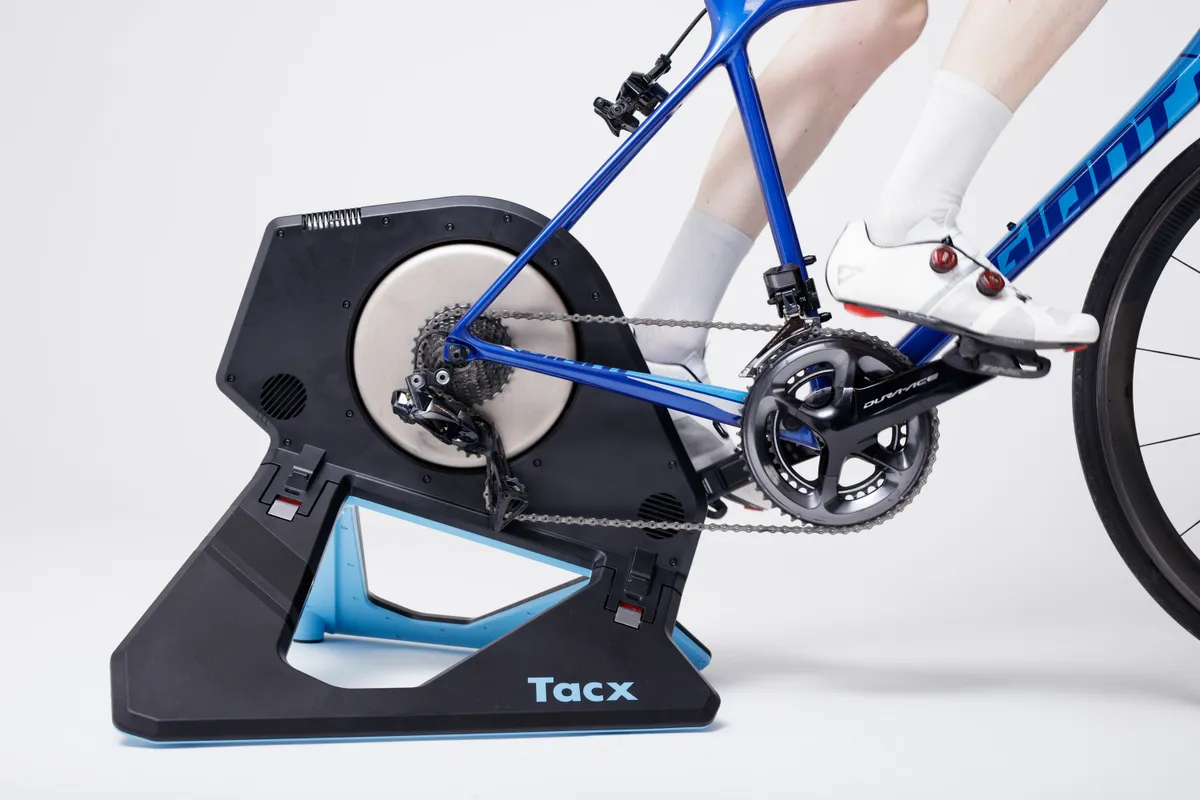
- £1,199.99 / $1,399.99 / AU$1,899.99 as tested
- Pros: Accurate; ride feel
- Cons: No cassette included; no handle
The Neo 2T is Tacx’s top-of-the-range smart trainer and it’s priced accordingly. It looks like a spaceship, and its spec and performance are among the best out there.
The Neo 2T uses an arrangement of magnets to create a virtual flywheel, and this offers fantastic ride feel, along with the ability to change the level of inertia depending on the virtual terrain. Tacx also claims the Neo 2T power measurement is accurate to +/- 1 per cent, which is up there with the best bike trainers.
At this price, it’s a little disappointing that a cassette isn’t included and, at 21.5kg with no carry handle, it's not the easiest thing to move about. Overall, however, the Neo 2T is about as good as it gets in terms of performance.
When you consider that it can be used without a power source (making it useful for pre-race warm-ups) and that it’s also one of the quietest trainers available, you have a very compelling package. The only real problem is whether or not you can afford it.
- Read more: Tacx Neo 2T review
Specs
Max power: 2,200 watts | Max simulated gradient: 25 per cent | Weight: 21.5kg | Flywheel weight: Virtual | Noise: 61dB | Cassette included: No
SQUIRREL_13076896
Wahoo Kickr V6
SQUIRREL_TEXT_13079984
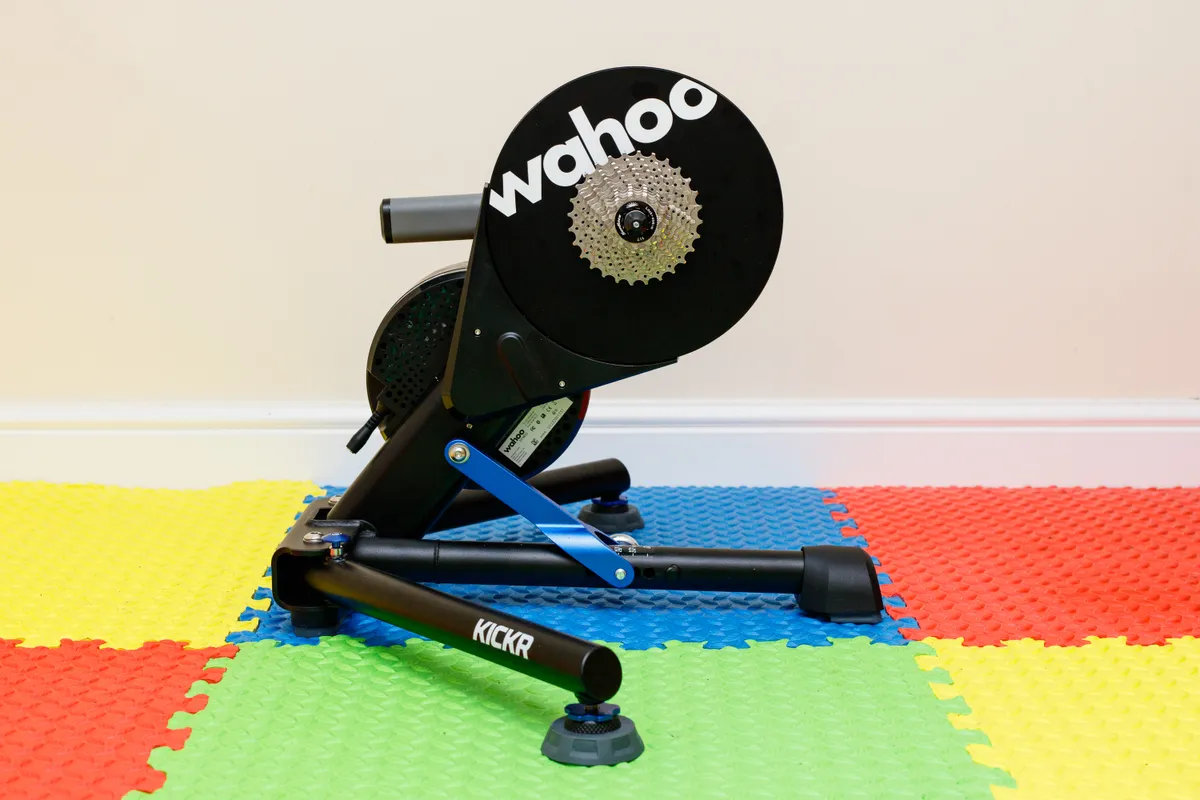
- £1,099 / $1,299.99 / €1,299.99 / AU$1,795.95 as tested
- Pros: Excellent ride feel; accurate data; quiet; WiFi connection
- Cons: High price in a competitive market
The Wahoo Kickr V6 is the brand's top-of-the-range model. The V6 replaced the Wahoo Kickr V5 in 2022.
Setting the unit up is very easy, especially with the addition of WiFi connectivity. While we've rarely had issues with Bluetooth connections, a WiFi connection means you should be able to connect to the trainer anywhere in your house that has a reliable 2.4Ghz connection. It also simplifies over-the-air firmware updates.
Wahoo includes a cassette and a generously sized power cable, so you shouldn’t need an extension lead.
The Kickr V6 is mechanically almost identical to the V5. Once your bike is installed, the trainer offers a very solid platform for sprints of up to 2,200 watts and gradients up to 20 per cent. There are trainers out there that offer higher top-end numbers, but this should be plenty for the vast majority of riders.
The Kickr V6 offers a fantastic ride feel, thanks to its relatively large 7.25kg flywheel. Like the outgoing trainer, it’s also wonderfully quiet.
Our testing showed the trainer's power accuracy aligns with Wahoo's claimed range of +/- 1 per cent. Like the V5, the trainer features automatic calibration.
The Kickr has never been a cheap smart trainer, and a £100 price hike for the latest model doesn't help that, but it does everything you need brilliantly and without fuss. Leaving value aside, our tester wrote: "the Wahoo Kickr V6 is easily one of the best smart trainers available".
- Read more: Wahoo Kickr Smart V6 review
Specs
Max power: 2,200 watts | Max simulated gradient: 20 per cent | Weight: 21.9kg | Flywheel weight: 7.3kg | Noise: 61dB | Cassette included: Yes
SQUIRREL_13079984
Elite Direto XR
SQUIRREL_TEXT_13079943

- £824.99 / $949.99 / €849.99 as tested
- Pros: Good ride feel; accurate data; folding legs
- Cons: Construction feels a little cheap
Priced between the cheaper Suito and top-of-the-range Drivo II, the Direto XR is an update to Elite’s Direto X direct-drive smart trainer, getting a heavier flywheel (5.1kg), an increase to the maximum simulated gradient (24 per cent) and a higher maximum power (2,300 watts).
The trainer comes with absolutely everything you need out of the box, including an 11-speed cassette. We wish the legs had a quick-release mechanism for folding them away, but the unit's (relatively) light 15.8kg weight makes it less of a chore to move around than others.
In testing, we found the trainer to be pleasingly quiet, with excellent ride quality and accurate power numbers to boot.
- Read more: Elite Direto XR review
Specs
Max power: 2,300 watts | Max simulated gradient: 24 per cent | Weight: 15.8kg | Flywheel weight: 5.1kg | Cassette included: Yes
SQUIRREL_13079943
Elite Zumo
SQUIRREL_TEXT_13079145

- £449 as tested
- Pros: Attractive price; integrated handle; ride feel
- Cons: Power data on the low side; cadence isn't that accurate
With an RRP of only £449, the Elite Zumo is one of the cheapest direct-drive smart trainers available.
It does an impressive job of replicating the premium user experience you get with pricier direct-drive trainers, and marks a genuine step up from wheel-on options, as long as you don’t mind the relatively low maximum resistance figures.
Serious esports racers may want to use an on-bike power meter to drive their avatar, though, because the Zumo’s internal power meter consistently read a few per cent lower than expected.
For general indoor riding though, the Elite Zumo is a great-value package.
- Read more: Elite Zumo review
Specs
Max power: 1,350 watts | Max simulated gradient: 12 per cent | Weight: 13.08kg | Flywheel weight: 4.2kg | Noise: 69dB | Cassette included: No
SQUIRREL_13079145
Pinnacle HC Turbo Home Trainer
SQUIRREL_TEXT_13112960

- £499.99 as tested
- Pros: Easy to set up; high maximum gradient; reasonably quiet
- Cons: Sporadic power data drift; non-folding legs; SRAM XDR or Campagnolo freehubs not available
The Pinnacle HC Turbo Home Trainer is a budget-conscious, direct-drive smart trainer from the in-house brand of UK cycling retailer Evans Cycles.
With a comprehensive specification for its price, the Pinnacle trainer impressed in use, offering easy setup, good ride feel and quiet operation.
In terms of data accuracy, our tester noted some sporadic power drifts and the cadence measurement wasn't always spot-on, but pinpoint perfect power accuracy is a rare feature at this price and these faults didn't overly affect the ride experience.
Overall, if you're looking for a direct-drive smart trainer on a tight budget, the Pinnacle HC Turbo Home Trainer is well worth consideration.
- Read more: Pinnacle HC Turbo Home Trainer review
Specs
Max power: 2,500 watts | Max simulated gradient: 20 per cent | Weight: 14.8kg | Flywheel weight: 5.7kg | Noise: 65dB | Cassette included: No
SQUIRREL_13112960
Van Rysel D100
SQUIRREL_TEXT_13176955

- £259.99 / €299.99 as tested
- Pros: Direct drive design at a low price; good ride feel; generally accurate power measurement
- Cons: 600 watt maximum power output is limiting; no the most accurate cadence data; no ANT+ FE-C connectivity
The Van Rysel D100 offers great value for money being one of the cheapest direct-drive smart trainers on the market and including Zwift Cog and Click shifter.
Despite the low price, the D100 shares a similar shape to trainers three times it's price and offers generally accurate power data.
We did find the 600 watt maximum power output to be limiting, but for those not looking to push past this intensity then it could reasonably be overlooked.
The cadence data wasn't as consistent as other trainers we have tested, but considering the price of the trainer it's performance is very impressive.
- Read more: Van Rysel D100 review
Specs
Max power: 600 watts | Max simulated gradient: 6 per cent | Weight: 10.78kg | Flywheel weight: 3.2kg | Noise: 58dB | Cassette included: Zwift Cog included
SQUIRREL_13176955
How we test smart trainers
Simon von Bromley – senior technical writer
I’ve been BikeRadar’s main smart trainer tester for the past few years, and have tested nearly all of the latest models.
With the rise of indoor cycling apps, such as Zwift, Rouvy and TrainerRoad, having a smart trainer that can accurately translate your input at the pedals to numbers these apps can use is more important than ever.
Given this, I benchmark each smart trainer against at least two additional power meters, by simultaneously recording data from test rides.
By comparing the data captured from each source, I can then determine whether the numbers produced by a trainer are within acceptable error margins (as defined by the manufacturer's claims), compared to power meters I’ve previously cross-referenced against other devices.
I also do a series of rides designed to test a smart trainer’s responsiveness and ride feel, including virtual group rides and races, simulated climbs and ERG mode workouts.
Lastly, I use my phone to record decibel data from each smart trainer, to determine how loud it is during use.
As with all products, I also consider how easy a smart trainer is to set up and live with, and whether it offers good value compared to the competition.
Why you can trust BikeRadar
BikeRadar has been an authority on bikes and cycling tech since its inception in 2007, delivering the world’s best riding advice.
We have experts testing all types of bikes, parts, clothing and accessories, from road, mountain and gravel bikes to commuting, bikepacking and electric bikes.
Our reviews are always editorially independent – with no exceptions. Our reviewers comprehensively test all products in the real world, always reflecting on performance, value and the wider market when delivering their verdicts and review ratings.
We have more than 15,000 product reviews available at your fingertips, as well as expert buying, maintenance, training, skills, health and fitness advice.
Our annual Bike of the Year test is an industry benchmark and the BikeRadar team consists of some of the most experienced riders and testers in the business.
What to look for when buying a smart trainer
What is a smart trainer?
Smart trainers are interactive turbo trainers that connect with indoor cycling apps such as Zwift, TrainerRoad and MyWhoosh, to control the trainer’s resistance and replicate hills, headwinds and drafting effects inside virtual worlds.
These apps can also guide you through power-based interval workouts, with the resistance automatically adjusting to keep you in the required training zones (this is known as ERG mode).
If you're unsure which of these apps is best for you, read our Zwift vs Wahoo vs TrainerRoad comparison article.
Today's smart turbo trainers work by communicating with third-party apps on smartphones, tablets and computers using wireless ANT+ frequencies or Bluetooth.
It sounds complicated, but most of these trainers and apps will automatically search for and connect to each other with the click of a button, so in practice, it’s usually very simple.
Wheel-on or direct drive?
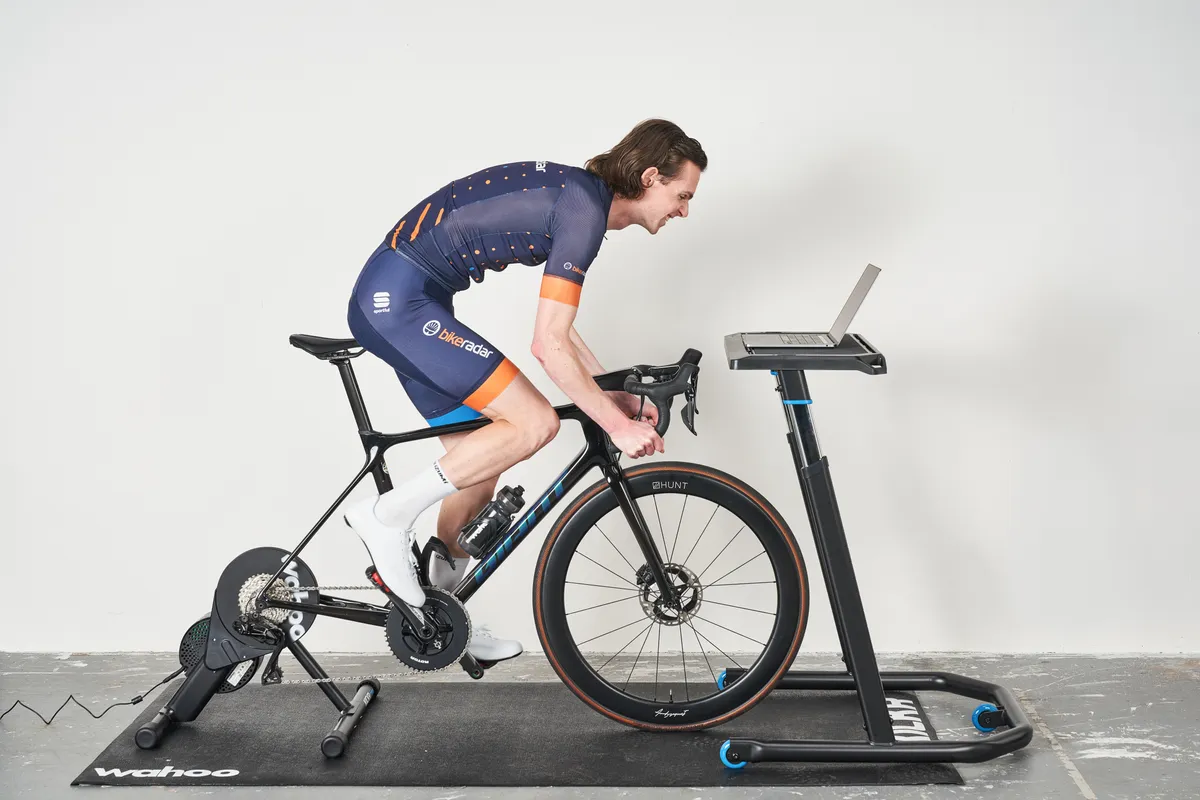
There are two main types of smart trainer: wheel-on and direct drive.
Wheel-on smart trainers
Wheel-on smart trainers function like classic, ‘dumb’ turbo trainers – you clamp the rear axle into a support while your rear wheel rests on a roller drum. This drum is connected to a resistance unit that communicates with your chosen hardware and app to control the resistance you feel through the wheel.
These are typically the cheapest and lightest types of smart trainers, but they can cause wear on your tyres (though specific trainer tyres are available to mitigate this issue), their power measurement is generally less accurate and the ride feel often isn’t as good as direct-drive trainers.
This is most often the noisiest type of indoor trainer, too.
Direct-drive trainers
Direct-drive trainers require you to remove the rear wheel and connect your bike to the trainer via a standard cassette. These are heavier and more expensive than wheel-on trainers, but prices are getting more competitive and they have a number of advantages.
Outside of the obvious one – a lack of wear on your lovely rear tyre – they also tend to be quieter and offer a more realistic, road-like ride feel. They are also usually much more feature-rich and accurate – in terms of power measurement – than wheel-on trainers.
Of course, price is always going to be a major consideration. So we’ve tested a range of options to suit as many budgets as possible, but there’s no denying these trainers aren’t cheap.
However, compared to a road bike groupset upgrade, or even a new winter road bike, they can offer good value if you want to be able to consistently and enjoyably train indoors.
Price
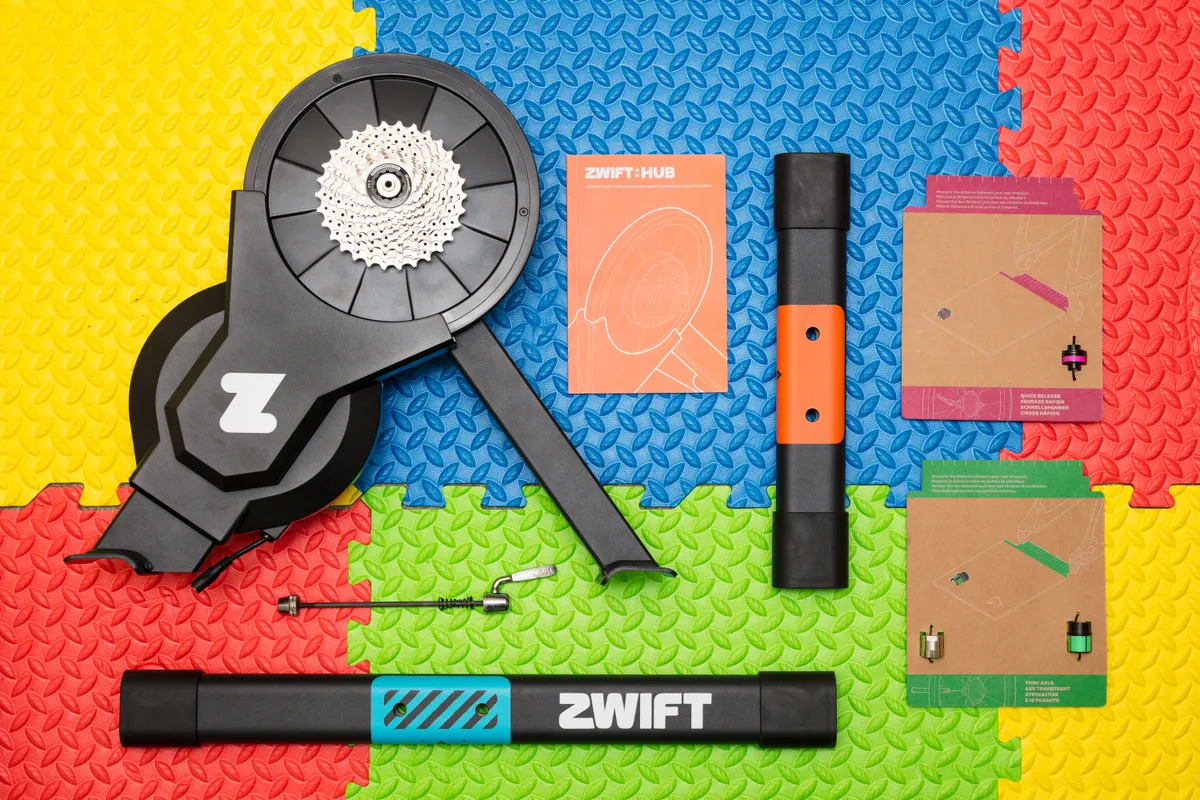
How much you have to spend will ultimately dictate what kind of smart trainer you get, but it's certainly possible to put together a good indoor cycling setup on a tight budget.
Smart trainers at the lower end of the price scale tend to compromise on things such as power accuracy and noise levels, but should still offer an immersive experience. High maximum power outputs or leg-breakingly steep gradients are nice to have, but far from essential, so don't be swayed by on-paper spec alone. Do you really need a trainer capable of handling a 2,000-watt sprint?
If you've got lots of money to spend, then, as usual, you'll have far more options to choose from.
In our experience, the biggest leap in performance comes around the £500 mark, where direct-drive models start to appear. The ride feel, noise levels and power accuracy all typically take a big step up at this point, and beyond that it's all marginal gains.
Flywheel

A flywheel helps to create a road-like feel due to the kinetic energy they’re able to store, and the resultant inertia they give – essentially, when you stop pedalling it should feel like you're coasting on a real road.
It’s generally considered that the heavier the flywheel, the better the ride feel ought to be, but this isn’t always the case. Construction, materials and design all play a role, and some brands are in fact now using virtual flywheels with magnets.
Though more expensive, virtual flywheels have the advantage of being able to change the level of inertia depending on the virtual terrain – so climbing should feel different to riding on the flat, just like in the real world.
Weight and packability
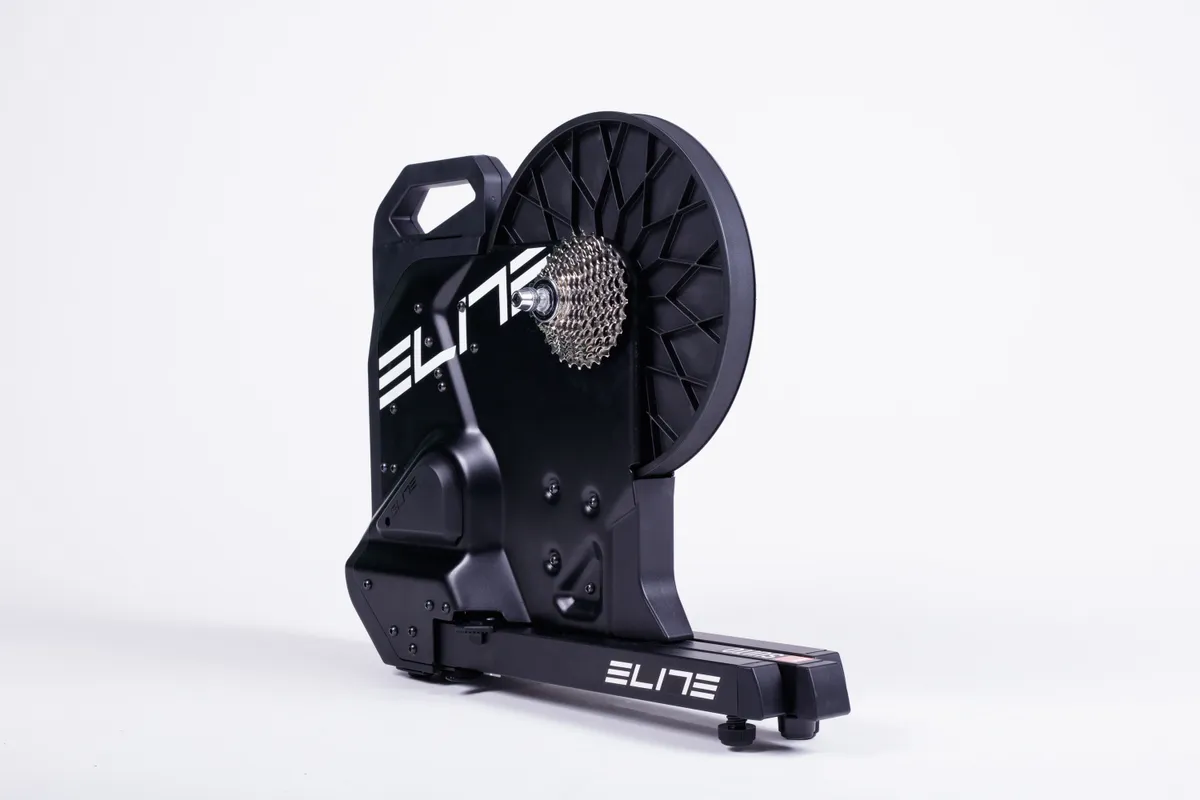
Trainers come in a wide variety of shapes, sizes and weights. Wheel-on trainers are, more often than not, the lightest and most packable kind of trainer.
Direct-drive trainers tend to be much bulkier. Though size and shape can vary wildly – with some models folding up to a very slim form – they tend to all be pretty heavy regardless.
If you’ve got a dedicated pain cave, it may not matter at all how big and heavy your trainer is. But if you have to set it up and pack it down before and after every session, then you’ll need to take this into consideration, especially if you can't fold down the supporting legs of a trainer or it lacks a carry handle.
Power and gradient

Trainers have different maximum power figures that correspond to the amount of resistance they’re able to generate. They typically range from around 1,500 watts to over 3,500 watts.
1,500 watts should be plenty for most people, and 2,000-watt models ought to be enough for practically everyone except professional sprinters.
The gradient figures relate to the maximum incline a trainer can simulate – given in per cent, like on the road. Again, a lower figure isn’t going to hinder your training, it simply means those trainers won’t be able to simulate the virtual world perfectly whenever the gradients go beyond what the trainer is capable of.
However, many indoor cycling apps, including Zwift, automatically set the difficulty level to 50 per cent, so a 10 per cent 'real life' gradient will feel like five per cent on a smart trainer.
Unless you're planning to change the app's difficulty setting, this may mean you don't need as high a spec as you think.
Noise

Indoor trainers used to be notoriously noisy, but there have been vast improvements made over the past few years. Wheel-on trainers are still typically louder than direct-drive trainers, but the gap has narrowed somewhat.
Direct-drive smart trainers are typically the quietest, with some models being so quiet that the sound from your drivetrain becomes the main source of noise.
For both types of trainer, though, the noise levels tend to increase as your power output and the flywheel speed go up.
If you want to be able to do interval training sessions inside your house or flat early in the morning, perhaps before your partner/family/housemates wake up, or after work when they’re trying to watch their favourite series in the next room, a quiet trainer is a must.
If you have your trainer set up in a garage, on the other hand, it's less of an issue.
Useful accessories
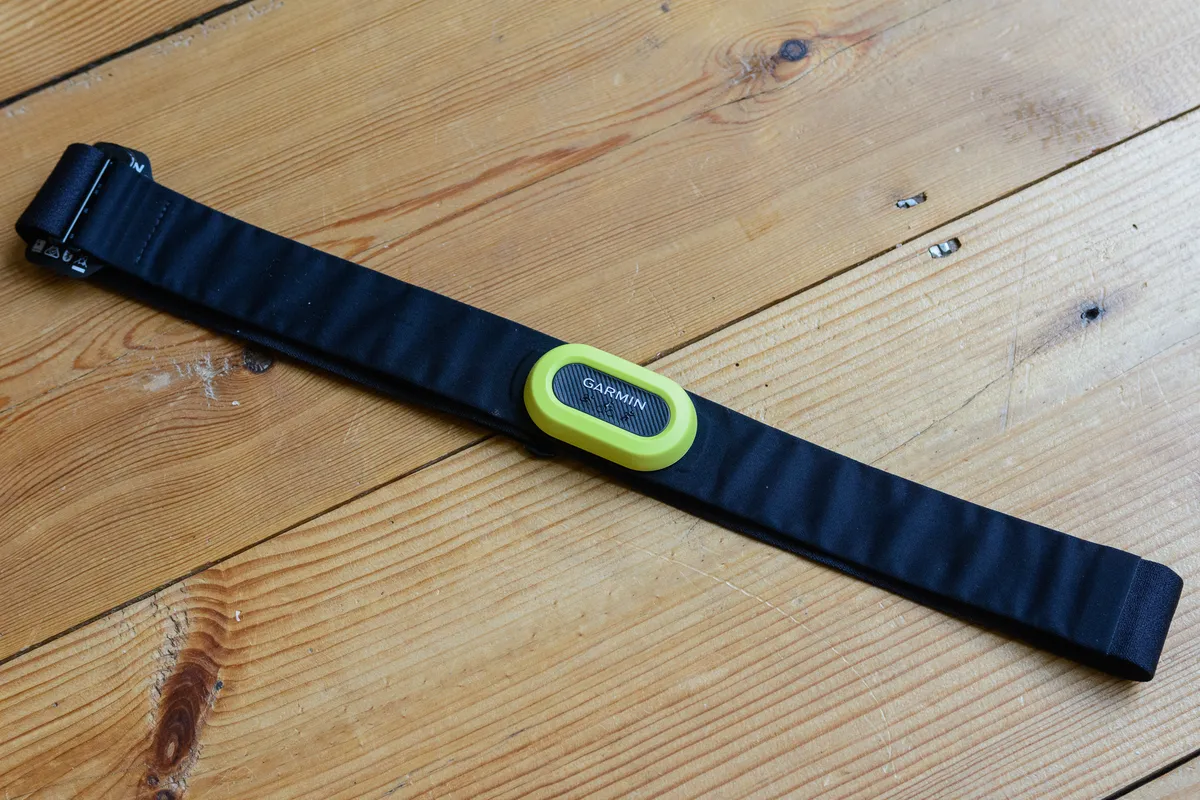
Once you've got all of the essential items, there are still a few extra turbo trainer accessories that can make your indoor cycling sessions even more enjoyable.
First of all, most smart trainers need to be plugged into the mains electricity supply in order to function properly. A good-quality extension lead might therefore be necessary, depending on where you’re going to set up the trainer, because the supplied plugs don’t always have super-long wires.
We recommend using Bluetooth to connect all of your hardware together, but if you have ANT+ accessories (such as an older power meter or a heart rate monitor) that you also want to connect, then you’ll need an ANT+ dongle for your laptop or tablet.
You might need a riser block for your front wheel. Whether you do depends on the model of trainer, but it’s worth checking – those trainers that need a riser block to level you out don’t always come with one included.
Even if your trainer doesn't technically need one to level the bike out, using a front wheel riser block can also increase stability, as it helps to stop your front wheel from moving underneath you. They’re not that expensive, either (unless you want it to be, in which case Wahoo will sell you its Kickr Climb gradient simulator).
A trainer mat of some sort – preferably one that’s rubberised underneath to help it stay in place – will help catch your sweat, and will also help dampen vibrations and keep noise levels down, especially if you’re using your trainer on a wooden floor (which tends to amplify the sounds).
Sweat nets that cover your top tube, steerer tube and stem might also be a good investment to protect them from perspiration and corrosion (also, read our advice on using a carbon bike on the turbo trainer).
However, what you really want is a big, powerful fan. Something around 20 inches will do, or if you’re really flash you can get a ‘smart’ fan such as the Wahoo Kickr Headwind.
If you’re using a laptop or a tablet, a specific stand or table to hold it in front of you is very useful as well, or if you want to use a TV, the Apple TV box is able to use the Zwift app.
What about smart bikes?
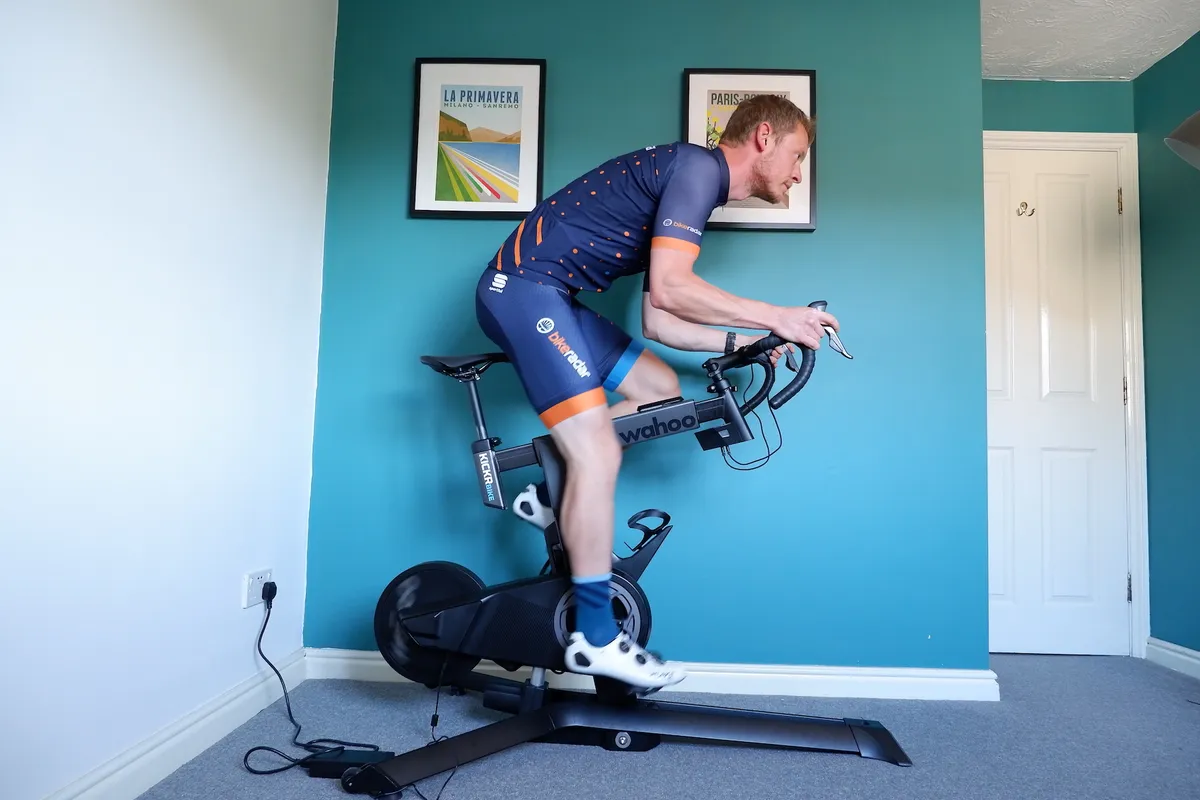
If you're really dedicated to indoor cycling, there is another tier of smart cycling device available; the smart bike.
The best indoor bikes offer all of the features a top-end smart trainer does, plus more, making them a perfect fit in the best Zwift setup. Once assembled, they'll always be ready and waiting for you to jump on and start pedalling, and they're essentially maintenance-free too.
The downsides? First of all, they're typically very expensive. You'll also need a dedicated space to use it in, as they're far too big and heavy to put away for storage when not in use.
Why should you train indoors rather than just ride outside?
This is a fair question and one that really has a very personal answer.
However, most of us will probably admit that we don’t enjoy getting wet, cold or dirty.
Furthermore, if you live in a particularly busy part of the world, training indoors can be much safer. If you’re doing hard intervals to exhaustion or training in a time-trial position out on the open roads, you really need to be careful of traffic.
Training indoors can save you from all of that, and in a more positive light, training indoors can be extremely time-efficient if you're following a Zwift training plan, or something similar on another platform.
Virtual riding is now so popular that there are organised online group rides and Zwift races, so you can indulge your competitive urges at all hours to make it more fun.
